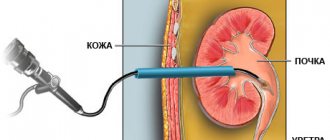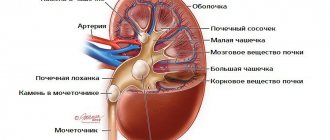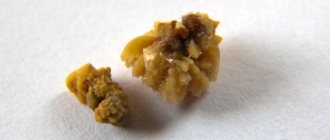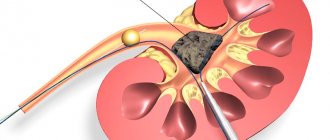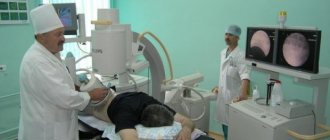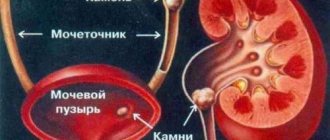Kidneys
24.08.2016
Greetings readers. Today we’ll talk about phosphate conglomerates - this is a type of stones that form over time in the kidneys. They differ from urate and oxalate formations in that if a special diet is not followed, they can increase quite quickly and, as a result, cause a lot of trouble for their “owner”. Therefore, the correct diet for phosphate kidney stones and properly selected food products in the complex therapy of this disease are very important.
- What are phosphate stones?
- What is the reason for the formation of stones?
- How does the disease manifest itself?
- Treatment and diet
- What diet should you follow if you have phosphate stones?
- The main essence of the diet
- What's not allowed?
To understand how a diet can help, you should first understand the reasons for their formation and how else they differ from conglomerates of other types.
General information
Phosphate stones are formed due to an excess of calcium salt and phosphoric acid in the body.
Externally they are smooth, light in color with a grayish tint. Due to their smoothness, the stones do not damage the renal pelvis. Most often, the appearance of phosphates is observed with pyelonephritis.
The danger of such stones is that in just a week they can grow from small sizes to coral stone. At the same time, at the initial stage of the disease there are no signs .
Another feature of phosphates is the fact that they are formed not in the kidney itself, but in the renal pelvis. Therefore, when they reach large sizes, stones can block the urinary system, which can lead to death.
Features of the course of the disease and diagnosis
The clinical manifestations of phosphate stones are determined by the peculiarities of their structure. They have a smooth surface and do not injure the mucous membrane. Therefore, the disease does not manifest itself for a long time.
Due to their tendency to grow rapidly, they can fill the entire pelvis. For this reason, phosphate stones are sometimes an indication for surgical removal of the organ (nephrectomy).
Nephrectomy
They are often accompanied by infectious inflammation of the kidney – pyelonephritis.
It is extremely rare for a patient to be bothered by a dull aching pain in the lumbar region. It can intensify due to long walking, physical activity, and heavy lifting.
Diagnosing phosphate stones is not difficult. In clinical urine analysis, a stable increase in pH value is observed (usually above 7.0).
If a bacterial infection occurs, then an increase in the level of leukocytes and bacteria is observed. Since the inner surface of the kidneys is not injured by the surface of the stone, there are no red blood cells in the urine.
The concentration of various salts is determined by analyzing 24-hour urine.
A biochemical blood test is indicative, since its results can be used to determine changes in the concentration of various compounds in the blood plasma, including phosphorus and magnesium.
Instrumental diagnostics
Phosphate stones are visible during ultrasound and x-ray examination. They are distinguished by high density, smooth surface and irregular shape.
In addition, based on the results of these studies, one can judge the size of the stones, the degree of kidney damage, and the general condition of the urinary system.
To assess the functioning of the kidneys, ureters and bladder, and determine the exact location of the stone, the patient is injected with a contrast agent, which is excreted in the urine.
The movement of the contrast is monitored using a series of x-rays. This research method is called urography.
The most informative are the results of computed tomography and magnetic resonance imaging.
Reasons for appearance
The main reasons for the formation of phosphate stones:
- genitourinary infections;
- increasing the pH level to 7 and above;
- the occurrence of an alkaline reaction in the urine;
- poor diet (eating foods that increase calcium levels);
- physical inactivity;
- increased salt content in urine;
- impaired metabolism;
- lack of vitamins A, E, D, etc.
In addition, the formation of phosphates can be influenced by the climate in which the patient lives.
Diet
For patients with phosphate stones in the kidneys, a special diet has been developed that helps stop the growth of formations and even reduce them. Patients need to exclude from their diet foods that cause alkaline urine. These include:
- Eggs;
- Mushrooms;
- Sour cream;
- Milk, dairy and fermented milk products;
- Herbs and spices;
- Smoked meats;
- Greenery;
- Canned food from the store (due to the large number of food additives in them).
Dairy products not only increase the amount of alkalinity in the urine, but also contain a lot of calcium. This also contributes to the growth of stones that contain this element. Therefore, you should exclude almonds, cheeses, poppy seeds, and sesame seeds from your diet. These are the leading products in calcium content.
The diet for phosphate stones in the kidneys should promote oxidation of urine. Therefore, it is useful for patients to eat:
- Meat and fish;
- Products high in vitamins B, A and D;
- Brussels sprouts;
- Peas;
- Flour products with the exception of fatty and rich products.
You can't drink coffee. But you can afford some weak tea without adding milk. If the diet is followed, then kidney stones will recede over time. However, even if you managed to completely dissolve and remove phosphate stones, continue to follow a therapeutic diet. Otherwise, the stones will begin to form again.
Characteristic symptoms
As already mentioned, at the initial stage it is almost impossible to detect stones. Since the stones are smooth, they do not cause severe pain when passing through the urinary tract, as well as blood in the urine.
And yet there are a number of symptoms by which you can determine the presence of the disease :
- pain in the lumbar region;
- decrease in urine volume;
- change in urine color (turbidity, see photo);
- swelling of the legs, which increases every day;
- exacerbation of cystitis;
- frequent trips to the toilet;
- pain when urinating;
- occasionally an increase in temperature (if an infection has started).
If any sign appears, you should immediately contact a specialist!
Basic information about formations
Phosphate stones are smooth, so they do not create severe discomfort.
Phosphates are stones that consist of calcium salts of phosphoric acid. It is because of this composition that they are easily detected during radiographic examination.
Smooth stones do not create any symptoms or painful sensations during their formation.
Phosphates have a whitish-gray tint. During their growth and development, they can become impressive in size, which becomes the main reason for surgical intervention to remove the organ.
The formations appear in the alkaline environment of urine and dissolve quite easily. To eliminate them, drug therapy and special nutrition for urolithiasis are used, which changes the acidity of the sick person’s urine.
What diagnostic methods are used?
A correct diagnosis can only be made after undergoing an examination and tests . You can diagnose phosphates using:
- Blood tests (general and biochemical). It shows the presence of inflammation.
- Urinalysis (general and biochemical), incl. sediment analysis. It shows the presence of inflammation, the pH level (acidic or alkaline), and helps to identify the type of stone.
- Ultrasound. Makes it possible to identify the presence of a stone, its location and size.
- X-ray. Allows you to determine the structure and type of stone.
- If necessary, the doctor may order tests to detect kidney failure.
Read our article about the symptoms of kidney failure.
The structure of the stone allows you to determine its type and prescribe the correct treatment .
Preventive measures
As a preventive measure, you need to be regularly examined by doctors of various specialties, and have your blood and urine tested.
An active lifestyle, proper nutrition, daily exercise and sports will also help prevent urolithiasis.
Phosphate kidney stones do not have sharp edges, so a person may not feel kidney colic and other symptoms for a long time. The walls of the kidneys are less damaged and no wounds appear.
If you experience recurring pain in the lower back, renal colic, or problems with urination, it is quite possible that the cause is stones or concretions. In advanced cases, phosphate stones can lead to disastrous consequences when irreversible processes occur in the kidneys and surgery for removal is required. But the problem can be solved if you undergo treatment on time and adhere to the diet recommended by doctors.
Treatment options
There are 2 ways to treat phosphate stones:
- Conservative.
- Operational.
It consists of medication and diet. If there is an infection, the doctor prescribes anti-inflammatory and antispasmodic drugs, antibiotics. Drinking plenty of water (mineral waters of the acidic category) is also recommended.
Since phosphates grow quickly, quite often drug treatment does not have the desired effect. In this regard, it is necessary to resort to surgical intervention.
Recently, classical surgery has been replaced by lithotripsy (crushing stones with ultrasound). Medium-sized stones are easily crushed and then come out naturally.
In rare cases, when the phosphate reaches particularly large sizes, laparoscopy is performed to remove the stone. The disadvantage of this method is the long recovery period.
Kidney stones and their types
Different types of stones cause different discomfort, the reasons for this are different. To determine the cause of the pathology and prescribe treatment, it is necessary to determine the type of tumor. According to their chemical composition, stones are divided into several types:
- Struvite - appears due to bacteria, is dangerous because it increases rapidly,
- Oxalates – have sharp edges and spines, over time they become coral-shaped, often brownish or black. The reason for the appearance is an excess of oxalic acid in the diet.
- Urates are yellow-orange in color, the surface is almost smooth. They belong to the group of uric acids. They can appear as a result of constant intake of salty and sour foods, lack of vitamin B, and diseases of the digestive tract. They are diagnosed only by ultrasound, but do not require surgical intervention.
- Carbonates are smooth and white. Considered a rare species. They are formed from salts of carbonic acid. Easy to dissolve, no crushing required.
- Phosphate porous stones are gray or white. Contain increased amounts of phosphates, ammonium, potassium, magnesium. This species is dangerous because they grow quickly - in a few months a formation measuring 5 millimeters can grow to 1.5 centimeters.
- Organic - light yellow cystines and black fragile cholesterol - can be caused by genetic changes and metabolic disorders. They are extremely rare.
Most often, it is not possible to accurately classify formations, since they are mixed and contain all types of urine salts. One kidney can contain two or three stones or as many as a hundred.
How to dissolve phosphate?
If the calculus was detected in the early stages, you can try to dissolve it.
To do this, you need to change the alkaline environment to an acidic one. For this purpose, the doctor prescribes special medications that help dissolve the formations. In addition, drinking plenty of fluids, drinking acidic mineral waters, following a diet, and herbal medicine (kidney preparations, diuretic herbs, knotweed, bearberry, etc.) are prescribed.
Physical therapy also helps remove stones. Bends, jumps, rotations of the torso, bending in the lower back - these exercises should be performed daily, until the stone comes out. Important: when performing exercises, do not forget to breathe deeply.
Prevention of phosphate stones
If medical examinations reveal a tendency towards phosphate stone formation, preventive measures will be following a diet and drinking plenty of fluids.
If medical examinations reveal a tendency towards phosphate stone formation, preventive measures will include following a diet and drinking plenty of fluids (described above) and increasing physical activity. Daily fitness exercises, swimming, running, or at least walking for at least half an hour, will make the kidneys work harder, actively removing salts and preventing them from lingering on the mucous membrane of the pelvis. In addition, physical activity will inevitably lead to increased infusion of water into the body, flushing the kidneys. In addition, you need to avoid the occurrence of inflammatory processes in the kidneys; if they appear, immediately consult a doctor to eliminate the source of inflammation.
ethnoscience
Herbal teas help prevent and treat urolithiasis.
Don't self-medicate! Before using any collection, consult your doctor.
Take equal proportions of larkspur, St. John's wort, dandelion root, tricolor violet and bird's eye knotweed. Mix it all. 5 tbsp. l. collection, pour 1 liter of boiling water and let it brew for an hour. Take a glass 3 times a day. The course of treatment is 2 weeks.
accelerates the dissolution of phosphates and facilitates their natural exit from the body:
- 1 tbsp. l. madder root;
- 4 tbsp. l. flax seed;
- 2 tbsp. l. dried sage;
- 2 tbsp. l. dry wheatgrass.
Mix herbs. Take 4 tbsp. l. collection, pour into a saucepan and pour 1 liter of boiling water. Cook over low heat for 15 minutes, then pour the broth into a thermos. Drink 1 glass per day 1 hour before meals. The course of treatment is until the stone is completely dissolved or comes out.
Types and methods of therapy
The treatment method for phosphate kidney stones is determined by the attending physician individually for each case.
The doctor’s decision is influenced by the severity of the disease and the individual characteristics of the patient’s body.
The nature of therapy can be either conservative or surgical. Traditional treatment is aimed at dissolving phosphates if they can be removed without surgery:
- treatment of existing infections;
- adherence to diet;
- taking medications to correct urine acidity;
- drinking mineral waters.
To dissolve phosphates and naturally remove them from the body, you should use the following methods:
- Resuming an active lifestyle and exercise. This could be walking outside or running.
- Refusal of foods that contain large quantities of calcium: alcohol, salty and spicy foods, dairy products, legumes, smoked foods, cocoa, chocolate and greens. You should also avoid chicken eggs, fruits and vegetables, which increase the alkaline level in the urine.
- The use of diuretics and antispasmodics. Drinking plenty of fluids promotes the natural passage of stones.
Phosphates can be successfully dissolved using the following medications:
Surgery for phosphate in the kidneys is very rarely used. Usually it is replaced by lithotrepsia - ultrasonic crushing. Surgery is resorted to when the stone formed is very large and there is no other way to remove it.
If surgery is indicated, the doctor prescribes a nephrectomy - removal of the stone using a laparoscope or standard surgical method. Laparoscopic nephrectomy is considered the safest and least traumatic.
During a routine surgical procedure, the surgeon gets maximum access to the diseased organ, so he can remove all the stones in the kidney. The only disadvantage of this procedure is long-term rehabilitation.
A little about phosphates
Phosphate stone is a compound of phosphoric acid salts. The stones have different shapes, a smooth surface and a grayish tint. They are quite soft to the touch and crumble easily. The formation of such stones occurs in conditions of alkaline urine, which normally should have an acidic environment.
It is much easier to remove phosphates from the body than oxalate formations, because they are easy to crush. Mineral water and freshly squeezed juices have a good effect on dissolving stones of this type. To remove phosphate compounds, tablets containing madder extract are used. They cannot be combined with the drug Cyston, which is suitable for eliminating oxalates.
Sample menu for a week with phosphate stones
In order not to get confused in the list of allowed and prohibited dishes, nutritionists recommend creating a menu for 7 days at once. This will make it easier to calculate your daily calorie intake and adjust it if necessary. And it’s easier to buy food.
Menu for phosphate kidney stones for a week.
Monday
| Breakfast | Boiled rice with a spoon of cow butter, whole grain bread with honey, tea with lemon |
| Lunch | Bun, rosehip decoction |
| Dinner | Chicken noodle soup, beef stroganoff, buckwheat, oatmeal jelly |
| Afternoon snack | Berry drink, crackers |
| Dinner | Minced liver, bread, red currant drink |
Tuesday
| Breakfast | Corn porridge, loaf with jam, rosehip infusion |
| Lunch | Bagels, lingonberry juice |
| Dinner | Meat soup with rice, beef stew with barley, jelly |
| Afternoon snack | Oatmeal jelly, gingerbread |
| Dinner | Krupenik with pumpkin, honey drink |
Wednesday
| Breakfast | Millet porridge with chicken breast, bread, tea with lemon |
| Lunch | Cookies, rosehip infusion |
| Dinner | Mushroom soup with beef and vermicelli, steamed cutlets with rice, lingonberry juice |
| Afternoon snack | Loaf, red currant or cherry plum jam, wheat bran decoction |
| Dinner | Pancakes with liver, rosehip infusion |
Thursday
| Breakfast | Oatmeal, omelette, bread, tea |
| Lunch | Whole grain crispbread, sour berry drink |
| Dinner | Rice soup with pork, chicken quenelles, pasta, rosehip infusion |
| Afternoon snack | Oatmeal cookies, berry jelly |
| Dinner | Meat soufflé, lingonberry fruit drink |
Friday
| Breakfast | Rice porridge with butter, loaf, green tea |
| Lunch | Pancakes, rosehip infusion |
| Dinner | Pea soup with meat broth, steak with pasta, tea |
| Afternoon snack | Berry soufflé, loaf with jam, wheat bran decoction |
| Dinner | Dumplings with mushrooms, oatmeal jelly |
Saturday
| Breakfast | Baked fish with rice, bread, green tea |
| Lunch | Gingerbread, rosehip infusion |
| Dinner | Fish soup with cereals, meat casserole, tea |
| Afternoon snack | Pancakes, berry jelly |
| Dinner | Spaghetti with a piece of cow butter, lingonberry juice |
Sunday
| Breakfast | Buckwheat with meat, loaf, tea |
| Lunch | Pancakes, a drink made from berries |
| Dinner | Chicken soup, beef liver with rice, tea |
| Afternoon snack | Loaf with jam, marshmallows, rosehip infusion |
| Dinner | Krupenik with pumpkin and honey, berry jelly |
The diet for phosphate urinary stones does not involve the consumption of dairy products, but a spoonful of sour cream added to the casserole will not do any harm. If you feel hungry, you are allowed to eat a bun, cookies or drink a glass of jelly.
If after three weeks of the diet the amount of phosphate salts in the urine remains the same, drug therapy is necessary. A properly balanced diet is just a way to avoid relapses and reduce the alkalization of urine. It cannot be used to cure urolithiasis.
Author: Elena Medvedeva, doctor, especially for Nefrologiya.pro
Medicinal herbs
Phosphate kidney stone tablets from the pharmacy can be replaced with natural herbs. This treatment method is especially suitable for patients with gastrointestinal and liver diseases. You can fight phosphates using moods and decoctions of the following plants:
- What is the correct diet for oxalate kidney stones?
- Dog-rose fruit.
- Leaves and roots of grapes.
- Knotweed.
- Bedrenets saxifrage.
Also effective against urolithiasis is a collection that is sold in pharmacies under the name kidney tea. Such collections may contain several varieties of medicinal herbs. You can choose a composition that will not cause you to be allergic to any components. The main thing is to follow the instructions and carry out treatment regularly, over time. This method is not designed for instant results.
Preparation
Your event is the dissolution of kidney stones. You can spend a long time on it. You must be determined to fight stones and thoroughly prepare for it.
You need to know what stones live in your kidneys. To do this, you need to donate urine and take an x-ray of your kidneys. Go to a doctor who will help you arm yourself with information against kidney “guests”, and at the same time give you advice on how to deal with them at home.
Attention! If the examination results indicate the presence of coral stones, dissolving agents are not used. Need surgery.
